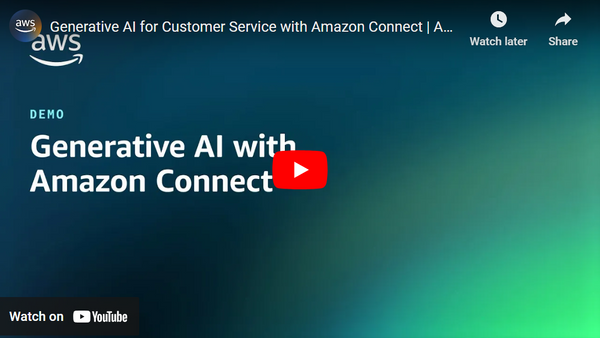6 Steps to Pick the Right Cloud Contact Centre Solution.
Conducting a viability assessment on a new cloud contact centre solution can feel overwhelming. In this guide, we'll walk you through our viability assessment approach to help you reduce the complexity and make the right choice!
Matt Sanders
There is no shortage of contact centre technology choices. And to make matters more complex, they all purport to solve every potential challenge your business may face. So how do you wade through the marketing and sales pitches to work out what solution is right for you without engaging in a complex and costly RFP process?
Conducting a rapid but robust viability assessment can ensure you move quickly but make the right call. In this guide, we'll walk you through the key steps in evaluating any cloud contact centre solution (including, of course, Amazon Connect!).
If you are one of those people that just wants the synopsis, here you go:)
1. Agree Business Needs and Goals
- Identify Specific Business & Customer Needs
- Articulate Short-Term and Long-Term Goals
- Critical to Include All Key Stakeholders!
2. Clearly Define Technical Requirements
- Assess System Compatibility
- Identify Key Systems Integrations
- Assess Compliance & Security
3. Understand Training & Support Needs
- Define Support Requirements
- Define Training Requirements
4. Do a Robust ROI Analysis
- Estimate Usage Costs
- Estimate Implementation Costs
- Analyse ROI
5. Analyse Alternatives
- Identify Alternative Solutions
- Compare Solutions Across Key Elements
6. Run a Proof of Concept (POC)
- Design and Run a Proof of Concept
- Evaluate Results & Make the Decision
1. Understanding Business Needs and Goals
Before anything else, understanding your business's specific needs and goals is paramount. Without a consolidated, cross-departmental view on this, you are setting yourself up for failure (i.e. don't do this by yourself, engage the broader business!).
A. Identify Specific Business & Customer Needs
- What things currently drive your respective teams crazy about your existing contact centre tech?
- What types of major customer experience improvements or business efficiencies are you targeting?
- How does your contact centre tech fit within your broader business strategy?
- What consumer, sector and broader macro trends are likely to impact what you need from your contact centre tech in the coming years?
- Which teams/departments do you need to "sign off" on these defined needs?
B. Define Short-Term and Long-Term Goals
- What immediate outcomes or "quick wins" are you seeking?
- What are the major CX innovation themes you are targeting over the longer term?
- What short term CX innovations are most appealing to your business?
- Are there any “show-stoppers”, being outcomes or features that are non-negotiable?
Answering these questions sets the groundwork for the entire assessment, providing a clear set of outcomes to align to. And again, without labouring the point, make sure you get the key stakeholders from across your business engaged at this stage!
2. Assessing the Technical Requirements
Evaluating the technical specifications requirements for your business and alignment to your contact centre technology is crucial to ensure the new CCaaS solution is the right fit. Get the relevant tech stakeholders engaged at this stage to ensure you know what is practically required to ensure a successful transition.
A. Assess System Compatibility
- What key elements are required for your new solution to work seamlessly with your existing infrastructure?
- Are there any necessary upgrades or changes needed to ensure the CCaaS solution works as intended (e.g. transition to softphones requiring headsets)?
- Assess internet connectivity and bandwidth needs, especially if your team is dispersed.
B. Identify Key Systems Integrations
- What existing tools, software, and systems must the new solution integrate with?
- Are there “out-of-the-box” integrations available within the new CCaaS platform or will custom solutions be required?
C. Assess Compliance & Security
- Are there any industry regulations and standards that are required to be met?
- What data security and privacy requirements/standards does the CCaaS provider already comply with?
- Does your organisation have any existing or planned security and data policies that need to be considered?
Understanding these technical aspects will highlight potential challenges and enable better planning as well as implementation cost estimation.
3. Training & Support
Proper support and training are vital for successful implementation and ongoing operation. It is critical you understand your unique requirements in regards to training and support and assess if they can be met through a CCaaS provider or their partners.
A. Define Support Requirements
- What specific support requirements does your organisation have?
- What level of internal support will your technology team be able to deliver?
- If there is a gap in internal support, can the CCaaS provider (or partner) provide it?
B. Define Training Requirements
- What are the major areas of training will your operational and technical teams need to use the new solution effectively?
- How can this training be provided?
Technical support and training considerations help ensure that your team can make the most of the new CCaaS platform from day one, but also ensure ongoing smooth operation and optimisation.
4. ROI Analysis
Given the various pricing elements and models that exist with the various CCaaS options in market, an ROI analysis that forecasts costs and commercial benefits is essential to ensure the new solution fits within your short and longer term commercial requirements, and that it represents value compared with other options.
A. Estimate Usage Costs
- Work with the CCaaS partner to model the forecasted usage costs - noting you ensure you use the most accurate forecast usage levels available and you consider the impacts of any licensing minimums or surge pricing for traditional CCaaS providers.
- Assess costs to support and maintain the solution, both internal and any external partner costs.
B. Estimate Implementation Costs
- Get an estimate of the costs to implement the new solution with the key integrations and customisations you’ve identified as business critical.
C. Analyse Potential ROI
- How will your new CCaaS solution improve efficiency, customer satisfaction, or other key metrics?
- Will these improvements translate into a positive return on investment?
A thorough cost analysis helps in making an informed decision based on financial considerations. This ROI calculation should be used in the next step to compare commercial outcomes with alternate solutions, as well as current state.
5. Analyse Alternatives
Understanding how the CCaaS solution compares to competitors and alternatives can provide a broader perspective.
A. Identify Alternative Solutions
- What other solutions are available that might meet your needs?
- How do they compare in terms of features, cost, support, and other critical factors?
B. Compare the Key Elements
- How does your preferred option stack up against these alternatives across the key elements such as i) meeting key business and customer requirements ii) aligning with key technical requirements and iii) meeting training and support requirements.
- What is the overall ROI for each alternative and how does they compare?
This analysis helps in making an informed decision by considering all available options.
6. Run a Proof of Concept (POC)
We don't believe in complex and costly RFP processes. We recommend selecting a preferred provider after completing steps 1-5, and then designing and deploying a cost-effective pilot or POC. This saves time and money, helps make a more informed choice and also means you create the base of your future production solution in the process. This POC can provide invaluable real-world insights and enable confirmation of assumptions used in your ROI and cost analysis.
A. Design a Proof of Concept
- Select a small group within your organisation to test your preferred solution.
- Set key success criteria and measure outcomes after a short-to-medium period (e.g. 3 months).
B. Evaluate Results
- Assess outcomes against your success criteria.
- Use actual usage and other data points to adjust your ROI calculation as required.
Pilot testing can reveal unforeseen challenges and benefits, guiding your final decision.
Conclusion
Conducting a viability assessment on any CCaaS solution is a multifaceted process that involves evaluating business and technical needs, support and training requirements, aggregated return on investment (ROI), and more. Taking the time to thoroughly assess each of these aspects ensures that a technology option is not only a viable solution for your business but one that will drive success and growth.
So What Next?
Considering Amazon Connect for your business? Our team of experts is here to help guide you through the viability assessment process and ensure you make the best choice for your unique needs. Contact us today to take the first step towards transforming your customer engagement with Amazon Connect.
Latest Stories
Here’s what we've been up to recently.

4 Practical Applications of Amazon Connect Contact Lens
Amazon Connect Contact Lens is a powerful tool designed to provide deeper insights into contact centre operations, improve agent performance, and deliver enhanced customer experiences. This article explores the key features of Amazon Connect Contact Lens and its practical applications, including creating reporting categories, real-time alerts for high-risk customers, theme
Matt Sanders

Generative AI & Contact Centres: A Practical Guide
Whilst there has been more than a decade of talk about AI in contact centres, with what many would say have been underwhelming practical applications, the introduction of recent advanced large language models (LLMs… think ChatGPT) is going to change the game.
Matt Sanders
